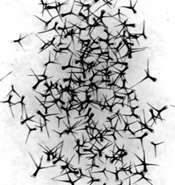Research Projects
Introduction
We are currently involved in two different aspects of plant development. The first is trying to understand how plant cell shape is controlled. Our model of choice is the trichome (plant hair) on the leaves of Arabidopsis plants. We are taking a combined genetic and molecular approach by isolating mutants that affect the shape of the trichomes, and isolating the genes that are identified by the mutations. Once the genes are in hand, we use a variety of cell biological and biochemical tools to determine the functions of the proteins they encode. We have recently isolated several novel genes that control aspects of cytoskeleton organization.
Our second project focuses on the evolution of the angiosperm flower. Our group is part of a larger consortium that is taking a comparative genomics approach to flower evolution. By comparing EST sequences from key basal angiosperm species, we hope to discover the basic set of genes needed to make a flower. Our role in this project is to examine the in situ expression patterns of genes encoding floral developmental regulators. To facillitate this aspect of the project, we have developed high-throughput methods to carry out in situ hybridization on large numbers of samples from many different species.
We use a variety of molecular, genetic, genomic, and cell biological methods and techniques in the Oppenheimer lab including:
- Positional cloning
- Transient and stable transformation of Arabidopsis plants
- Mutant analysis
- Overexpression and RNAi
- Intracellular localization of proteins using GFP fusions
- in situ hybridization
- Yeast two-hybrid analysis of protein-protein interactions
- Surface Plasmon Resonance
- Confocal microscopy
- Environmental scanning electron microscopy
Plant cell morphogenesis
The control of plant cell expansion is central to plant development. Plant cells cannot migrate during development; therefore, the shape of plant organs is to a large extent determined by precisely controlled cell expansion. The control of cell expansion is also of fundamental importance for the function of individual cell types. It is well established that the cytoskeleton plays an essential role in controlling cell expansion. However, the developmental signals that spatially regulate cell expansion, and the proteins that link these signals to cytoskeletal dynamics remain unknown.
We are using the morphogenesis of the Arabidopsis trichome (epidermal hair) as a model for how developmental signals control cell expansion. Using a genetic approach, we have identified more than 20 genes that control different aspects of trichome cell expansion. We have cloned several of these genes, and found that they encode proteins that function in either signal transduction or cytoskeleton regulation. Currently we are focusing on two genes that encode proteins of unknown biological function. We have shown that one of these is essential for proper actin organization at all stages of trichome development.
We are also continuing to isolate novel mutations that affect trichome morphogenesis, and are using genetic map-based methods for isolating the genes identified by these mutations.
High throughput in situ analysis of floral gene expression patterns
An open question in biology is how the diversity of flower structure arose. Our lab has developed high throughput methods to perform in situ hybridization to detect gene expression patterns in plant tissue sections. We are using these methods to examine floral gene expression patterns in basal angiosperms for hundreds of genes identified by florally expressed ESTs. These expression patterns will allow us to test hypotheses about the functional divergence of regulators of floral development during the evolution of the angiosperm flower.
We have also recently initiated a new project to determine gene expression patterns in Arabidopsis. Approximately 1/3 of the genes in Arabidopsis have no known function, and gene expression patterns will provide important clues. In addition, knowing the time and place of gene expression is particularly useful when searching for phenotypes during reverse genetic screens by focusing on attention on particular tissues or developmental times.
Trichome Proteomics
Using a method developed in our lab to isolate pure populations of trichome cells, we are preparing a catalog of all the proteins found in mature wild type trichome cells, and a collection of trichome shape mutants identified in our lab. The shape mutants are affected in specific steps of trichome development. By comparing the protein profiles of the mutants with that of wild type, we can learn which proteins are required at specific stages of trichome development.
